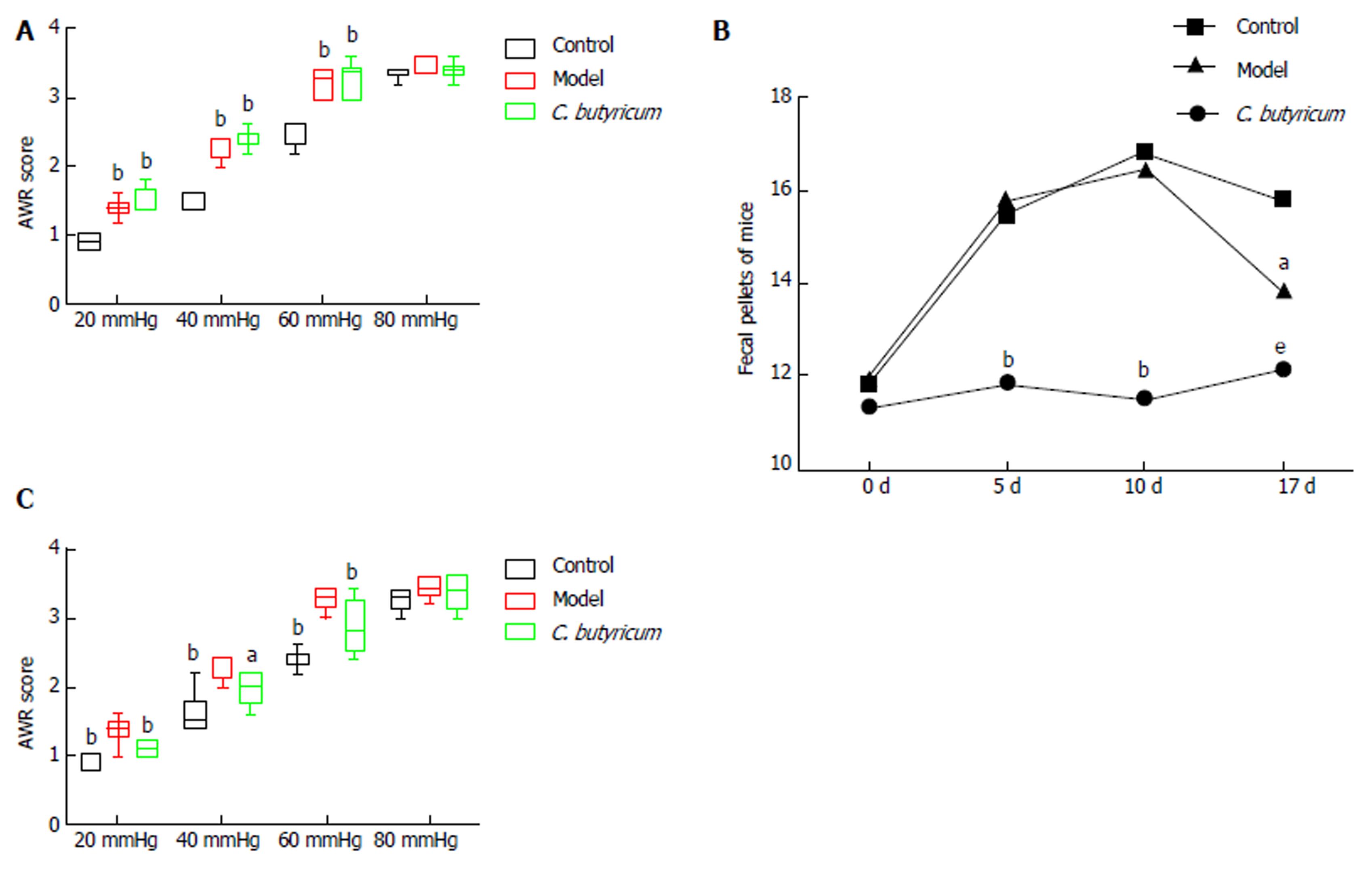Copyright
©The Author(s) 2018.
World J Gastroenterol. Feb 28, 2018; 24(8): 894-904
Published online Feb 28, 2018. doi: 10.3748/wjg.v24.i8.894
Published online Feb 28, 2018. doi: 10.3748/wjg.v24.i8.894
Figure 1 Impact of Clostridium butyricum treatment on irritable bowel syndrome mice.
A: Comparison of AWR scores between control and IBS groups, as well as between IBS and IBS + C. butyricum groups after WAS exposure (n = 6 per group). aP < 0.05; bP < 0.01. B: Fecal pellets at various time points during the experiment (n = 6 per group). aP < 0.05: IBS vs IBS + C. butyricum; bP < 0.01: control vs IBS, control vs IBS + C. buyricum; eP < 0.001: control vs IBS. C: Comparison of AWR scores between control and IBS groups, as well as between IBS and IBS + C. butyricum groups following the C. butyricum treatment period (n = 6 per group) aP < 0.05; bP < 0.01. AWR: Abdominal withdrawal reflex; C. butyricum: Clostridium butyricum; IBS: Irritable bowel syndrome; WAS: Water avoidance stress.
Figure 2 Heatmap of hierarchical clustering analysis for irritable bowel syndrome group vs control group at various time points.
The colors at different positions indicate the relative expression of the corresponding metabolites. C: Control group; M: Model (IBS) group. IBS: Irritable bowel syndrome.
Figure 3 Separating the irritable bowel syndrome group from the control group by metabolic profiling analysis.
A: Score scatter plot of PCA model for IBS group vs control group; B: Score scatter plot of OPLS-DA model for model group vs control group; C: Permutation test of OPLS-DA model for model group vs control group; D: Pathway analysis for IBS group vs control group. C: Control group; M: Model (IBS) group; PCA: Principal component analysis; OPLS-DA: Orthogonal projections to latent structures-discriminant analysis; IBS: Irritable bowel syndrome; C. butyricum: Clostridium butyricum.
Figure 4 Separating the group treated with Clostridium butyricum from the irritable bowel syndrome only group by metabolic profiling analysis.
A: Score scatter plot of PCA model for IBS group vs IBS + C. butyricum group; B: Score scatter plot of OPLS-DA model for IBS group vs IBS + C. butyricum group; C: Permutation test of OPLS-DA model for IBS group vs IBS + C. butyricum group; D: Pathway analysis for IBS group vs IBS + C. butyricum group. M: Model (IBS) group; Y: IBS + C. butyricum group; PCA: Principal component analysis; OPLS-DA: Orthogonal projections to latent structures-discriminant analysis; IBS: Irritable bowel syndrome; C. butyricum: Clostridium butyricum.
- Citation: Yu LM, Zhao KJ, Wang SS, Wang X, Lu B. Gas chromatography/mass spectrometry based metabolomic study in a murine model of irritable bowel syndrome. World J Gastroenterol 2018; 24(8): 894-904
- URL: https://www.wjgnet.com/1007-9327/full/v24/i8/894.htm
- DOI: https://dx.doi.org/10.3748/wjg.v24.i8.894












